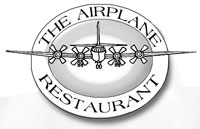

 |
 |
 |
 |
 |
 |
 |
 |
The Airplane Restaurant KC-97
The Airplane Restaurant KC-97 is rich in history, and luck. Returning from one
of the many refueling missions to Europe, our KC-97’s crew thought
they were going to have to ditch in the Atlantic. They couldn’t
remember where they put the Azores (islands located 970 miles west of
Portugal)! Luckily for the crew, the plane, and The Airplane
Restaurant, the Azores
were rediscovered and the plane didn’t end up on the bottom of
the ocean.
Boeing KC-97’s History
The Boeing KC-97 is one of the largest piston aircraft ever built by Boeing. Only one American-built piston aircraft, the Douglas Globemaster, is larger than the KC-97 (although the Globemaster’s payload is less and its speed is slower than KC-97’s) Powered by four 4360 Pratt & Whitney engines, the KC-97 was very powerful. Each 6,000 lb. radial engine has four banks of seven pistons, 28 pistons per engine generating 3,500 hp.
The first generation of KC-97s, then designated XC-97,
first flew November 15, 1944. It was designed to be the first long-range
transport with a large upper fuselage. The lower part of the fuselage,
including the wing and tail, are common with B-29.
On January 4, 1945, a C-97 set a new speed record from Seattle, Washington
to Washington D.C., 2,323 miles in 6 hours, 3 minutes and 50 seconds.
The variations of the KC-97 range from flight-refueling tankers, troop transport (seating for 80), cargo transport and the commercial, trans oceanic model 377 Stratocruiser (seating for 117). Solo’s KC-97 at one time was converted to the “L” Model. “L” designates two 15,200 lb. thrust General Electric J-47 turbojets, mounted outside of the outboard engines. These “jet assists” increased the KC-97’s speed to a compatible rate with the jets it was refueling.
Before these jets were added, it was common for KC-97s
to increase speed by entering a shallow dive so the faster planes, that
were refueling, would not fly so slowly they would stall.
Although Solo’s KC-97’s jets were removed years ago, if
you look, you will see an outline of where they were mounted.
The Wright Brothers
“Before the Wright brothers, no one in aviation
did anything fundamentally right. Since the Wright Brothers, no one
has done anything fundamentally different.”
-Darrel Collins, US Park Service, Kitty Hawk National Historical Park
Wilbur Wright was born Apr. 16, 1867, on a farm 8 miles from New Castle, Indiana, and Orville Wight was born Aug. 19, 1871, in Dayton, Ohio. Mechanics fascinated the brothers even in childhood. To earn pocket money, they sold homemade mechanical toys. Orville launched a weekly newspaper called “the West Side News,” with Wilbur as editor. Wilbur was 25, Orville 21, when they began selling bicycles. Then they began to manufacture bicycles, assembling them in a room above their shop. After reading about the death of pioneer glider, Otto Lili, the brothers became interested in flying.
Almost a century before Orville and Wilbur Wright took their place in history, the first fixed-wing aircraft, a kite mounted on a stick, had been conceived and flown. What the Wright brothers had accomplished was to design and build an aircraft that could be controlled while in the air. Every successful aircraft built since, beginning with the 1902 Wright Glider, had controls that roll the wings right or left, pitch the nose up or down, and yaw the nose from side to side. It is interesting that a sophisticated aircraft, recently tested, uses “warping” the wings to maneuver the plane. This is the same technique that the Wrights used in their epic flight.
The Wrights selected a narrow strip of land called “Kill Devil Hill,” near the settlement of Kitty Hawk, North Carolina. In 1900 they tested their first glider. It could carry one person. The glider measured 16 ft. from wing tip to wing tip. They returned to Kitty Hawk in 1901 with larger glider. But neither gliders, previously tested, had the lifting power they had counted on. They set up a 6-foot wind tunnel in their shop and began experiments with model wings. From the results of their tests, the brothers made their first reliable tables of air pressure on curved surfaces making it possible for them to design a machine that could actually fly, traveling distances of 600 feet.
Their gliders had proven their airplanes’ design to be sound and the brothers had become skilled pilots. In 1904, in a field near Dayton, they made 105 flights, but totaled only 45 minutes in the air. On Oct. 5, 1905, their machine flew 24.2 miles in 38 minutes, 3 seconds.
In 1908, they closed a contract with the U.S. Dept. of War for the first military airplane. They resumed experimental flights near Kitty Hawk. In Aug. 1909, the Wrights closed a contract for the formation of the “German-Wright Company.” Later that year, they formed the “Wright Company” in New York City, to manufacture airplanes.
Wilber died of typhoid fever on May 3, 1912. In 1913, Orville won the “Collier Trophy.” He sold his interest in the Wright Company and retired in 1915. Even after his retirement, Wilbur contributed to the advancement in aeronautics.
1665 N. Newport Rd.
One block east of Powers on Fountain Blvd.
Adjacent to the
Radisson Hotel Colorado Springs
719-570-7656
Email Steve Kanatzar, Managing Partner, at Click to Email Me
Menu | Specials | Our Plane | Parties & Groups | Catering | Map